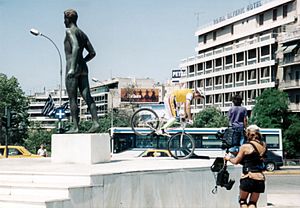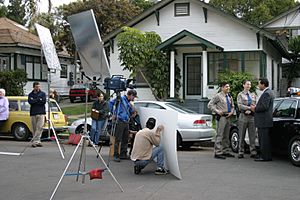Video production facts for kids
Video production is how we create video content. Think of it like making a movie, but instead of film, we use digital files. These files are stored on things like SD cards or computer hard drives.
Making a video has three main steps:
- Pre-production: This is all the planning before filming starts. It includes writing the script, making a schedule, and getting everything ready.
- Production: This is when you actually film the video. You capture all the moving images and sounds.
- Post-production: After filming, you combine the video clips. This involves video editing to tell a story or share a message. This can be done live or after the event.
Today, most video is captured on electronic media like SD cards for regular cameras. Professional cameras use solid state storage or flash storage. Videos shared online often use common formats like .mp4, .mov, or .avi.
Many companies specialize in video production. They use videos to help businesses grow and for marketing.
Contents
Types of Videos You See
There are many kinds of videos. Some common ones include:
- Movies and TV shows
- TV and internet commercials
- Videos for companies or products
- Videos where customers share their experiences
- Marketing videos
- Videos of events or weddings
The term "Video Production" means creating content with a specific audience in mind. It goes through all three stages: planning, filming, and editing. If you just film a concert or a family event with your phone to save memories, that's usually called a "home movie."
How Big Are Video Teams?
The size of a video team depends on the project. It's not about where you film or what you film. A bigger team often means higher quality. Some movies have been made by just two people. Some company videos use ten or more people.
Here are some examples of team sizes:
- One-person team: A single camera operator with a professional camera. They do everything themselves.
- Small team (2 people): One person operates the camera. Another person handles the sound.
- Medium team: Multiple cameras and operators are used. There's also a small support staff.
- Large team: Five or more people work on the project. This includes many different roles.
Cool Ways to Film Videos
Video production uses many of the same filming styles as filmmaking. The style changes based on the video's purpose. It also depends on the feeling or message you want to share.
Here are some common filming techniques:
- Tripods: These hold the camera steady for a "locked down" shot.
- Hand-held: The camera is held by hand. This creates a shaky, energetic feel. It often shows natural movement.
- Dutch angle: The camera is tilted to create a non-level, often unsettling, shot.
- Whip pan and Whip zoom: These are very fast camera movements. A whip pan quickly swings the camera horizontally. A whip zoom quickly zooms in or out.
- Jib or crane shots: These use special equipment to move the camera up and down. They are often used at the start or end of videos.
- Steadicam: This device keeps the camera super smooth. It's great for following people or action at slower speeds.
- 3-axis stabilized gimbal: This electronic device also makes shots smooth. It uses motors to balance the camera. Gimbals are lighter and more portable than Steadicams. They can go places a Steadicam cannot.
Videos for TV Shows
Two main ways to produce video for TV are:
- ENG (Electronic News-Gathering): This is for news reports.
- EFP (Electronic Field Production): This is for other shows filmed outside a studio.
TV shows include television commercials, newscasts, variety shows, game shows, live television, documentaries, and reality shows.
In the past, most TV was filmed on videotape. Now, many television stations use digital cameras. They also use digital files to send and store High-definition (HD) footage.
Videos for Learning Online
Video production is also used for online education. Teachers create scripts and organize content. They film and edit videos using computer software. These videos help students learn online.
This type of video production is special because:
- It adds to other online teaching tools.
- It can mix video, sound, computer animations, and pictures.
- It can use cameras from cell phones to professional HD cameras.
The main goal is to help students understand things better. This can be in live online classes or videos watched later.
Webcasting is also used for online learning. For example, the DiveLive programs allowed students to watch live underwater archaeology. They could even ask scientists questions in real time!
Making Videos for the Internet
Faster internet and new technology have changed video production. It's easier to create and share videos online. Many tools let you make videos without a physical camera. For example, you can use existing video content on platforms like YouTube.
Videos are used online in many ways:
- Customer stories
- Videos explaining products
- Training videos
- Interviews
- "Thank you" videos
Marketing videos are made for specific goals. Explainer videos teach about a product. Commercial videos introduce a company. Sales videos help sell products. Social media videos build brand awareness.
Many small companies make their own internet marketing videos. Larger companies often use big media agencies. They also use online platforms to create many videos.
Most Internet marketing videos aim to connect with the audience. Some videos try to sell a product. Others are designed to keep people on a website longer.
See also
 In Spanish: Producción de videos para niños
In Spanish: Producción de videos para niños
- B-roll
- List of video topics
- Television studies



